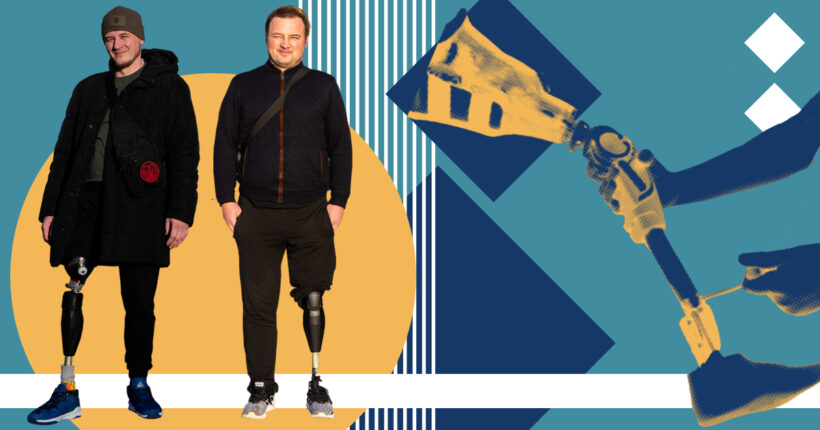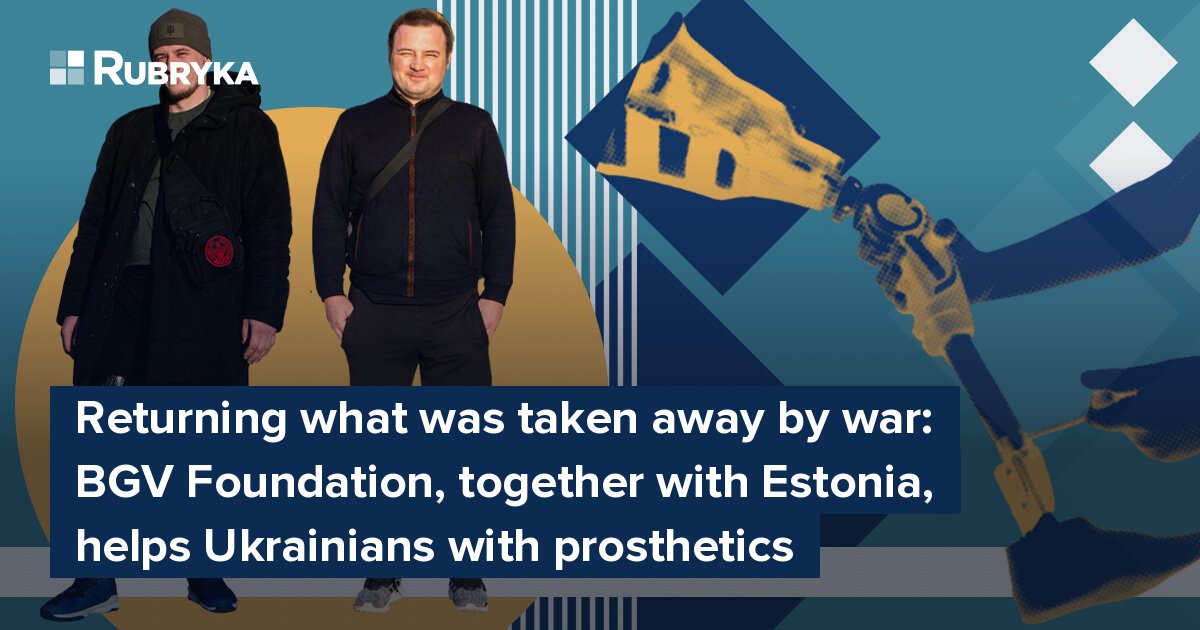
What is the problem?
The stupidest joke
Taras comes from the Lviv region. On February 24, his father came to him and said that the war had begun. The next day Taras was already at the military commissariat to join the ranks of the armed forces. He was assigned to the 15th separate artillery reconnaissance brigade, which in July was sent to the Kharkiv region after training. Taras jokes that they had to work for a short time.

On August 2, Taras and his comrades were in the trench and performed the task of adjusting the artillery with the help of UAVs.
As soon as the unit took off and began to inspect the area, an enemy tank came out and started working on us. At the ninth time, it hit the edge of our trench. The shrapnel hit all four who were there, including me. It hit my arms and legs, Taras recalls.
Fortunately, all defenders survived. Two pilots have badly damaged hands and knees. Taras received multiple fragments in his right leg. After a short treatment, it turned out that the leg could not be saved. The council of doctors decided to amputate, and Taras had no other choice but to agree.

"I called my wife and said that my leg was amputated. She is a very positive person and has a great sense of humor. She says, "That's the dumbest joke I've ever heard." And I say: "It's not a joke," Taras says with a smile.
After some time, the defender was taken to Lviv for further treatment. After severe trials, the question of prosthetics arose.
"Then I woke up, and my leg was gone"
Oleksandr comes from Chernihiv region. In March, during the encirclement of Chernihiv, he was injured as a result of an accident: a bullet pierced the bone of his left leg, tore out a large part of the muscle, and hit a nerve and an artery.

Oleksandr recalls that the first surgery took five hours. It was difficult to leave Chernihiv due to the blowing up of bridges, but they managed to take him to the Kyiv clinic. They tried to treat the soldier, but the infection spread, a thrombus formed, and the bleeding started. He was taken to the operating room, and when the defender woke up, his leg was gone.
After the amputation, Oleksandr was sent to the Kyiv Institute of Traumatology and Orthopedics. Here, the treatment continued for another two and a half months, but the wound did not heal at all. Oleksandr decided to go to Austria, where he continued his treatment.
"Another two centimeters of bone were amputated. Already after that, in three weeks, everything healed. Then I transferred to a rehabilitation center, and they made my first mechanical prosthesis there," says Oleksandr.
What is the solution?
The project aimed at prosthetics and rehabilitation of Ukrainians
Since the beginning of the full-scale invasion, volunteers of the BGV charity fund have begun to purchase and deliver humanitarian aid to vulnerable categories of the population, the military, medical institutions, and volunteer organizations. Assistance to the military later turned into a full-fledged rehabilitation project.

Nadia Stechyshina with Oleksandr and Taras
The project coordinator, Nadiya Stechyshina, says that last year the foundation had another initiative related to rehabilitation. During the Forum for the Restoration of the Zhytomyr region in Estonia, foundation volunteers met representatives of the Ministry of Social Affairs of Estonia.
"During the conversation, when we shared the foundation's achievements and ideas, we heard that there is a desire to help Ukraine's defenders in the context of rehabilitation. We offered help and compensation for additional expenses," says Stechyshina.
Cooperation between Estonia and Ukraine in the medical field began in 2014. And after the full-scale invasion, the government of Estonia started a large-scale program to treat the Ukrainian military and civilians. Estonians wanted to deepen the interaction as much as possible. Moreover, if certain countries are ready to help only wounded civilians, then Estonians, on the contrary, try their best to help those who protect Ukraine from Russian occupying forces.
"In October of last year, we considered the request of one of the divisions for a thermal imager. It was on Monday, and on Wednesday, this unit came under fire, and one of the guys we talked to, Artur, lost his leg. We have moved from thermal imagers to a new level. Already in April, this soldier went for treatment and prosthetics, and literally at the beginning of May, Artur will return with the Genius X3," says Stechyshina.
The BGV charity fund became the operational link of the program to send Ukrainians for rehabilitation abroad. The fund seeks participants for the program through official state representatives.
How does it work?
Electronic prosthesis and special exercises
Taras and Oleksandr were the first to go to Estonia for rehabilitation with the support of the BGV charitable foundation. The fund was looking for more complex cases — amputation of the lower limb above the knee, double amputation. These cases are more expensive and difficult to treat in Ukraine, although the level of our specialists is constantly growing, and the market is developing.

Volunteers first offered Oleksandr the opportunity to go to Estonia for rehabilitation and receive an electronic prosthesis instead of a mechanical one, and he agreed.

Taras says that he found out about it a little differently.
"My hospital roommate told me that a volunteer is looking for someone with an injury above the knee for new prosthetics and rehabilitation abroad. That's how I got involved," says Taras.

After some time, the project coordinator Stechyshina contacted the defenders. After quickly coordinating and processing all documents, they went to Estonia. The soldiers went through the complicated procedure of going abroad in two weeks. The Ministry of Health of Ukraine helped the foundation team with this.
Stechyshina recalls that the management signed the letter on Saturday, January 21, as soon as all the documents were uploaded so that the defenders could leave the next day. Even there, they faced some challenges: data was not uploaded to the system for a long time at the border point. However, with his optimism, Taras solved even technical problems: "Well, can't you see that the defenders are going for treatment?!" he said with a smile during the examination, pointing to the amputated leg. And then he added with understanding: "And you can't put a stump on the scanner…". This is now a catchphrase for the foundation team.
Taras and Oleksandr spent three weeks in Tallinn, received Genius X3 electronic prosthetics, and performed special exercises for their new legs for an hour and a half daily.
Among the exercises performed by the defenders were both ordinary slow walking and complex exercises with simulators. During rehabilitation, the defenders learned to climb stairs and walk quickly.
Stechyshina says the Tallinn clinic practices occupational therapy (ergotherapy, — ed.). This type of physical rehabilitation aims to restore a person's daily activities, considering existing physical limitations.
Contractors manufacture genius X3 prosthetics for the Tallinn Clinic. One of them is the leader in prosthetics, Ottobock. The approximate cost of one such prosthesis is $70,000. In the clinic, an individual stump receiver is made, connecting the body part and the prosthesis.

Taras initially thought about biometric prosthetics, but now he is satisfied with the electronic one. The prosthetic has several modes — walking, cycling, running, and fixing the leg in one position. It is more convenient than a mechanical one, and it is also more functional.
The main feature of such prostheses is the mobile application developed for them, which can be easily downloaded to a smartphone. Thanks to this, it is possible to view, select and enable all modes of the prosthesis. For example, if you choose the running mode, the prosthesis will begin to bend faster in the knee area and adjust to the second leg. With the mobile application, users can quickly and easily switch modes for any need.
On the very first day after returning to Ukraine, Taras went home to the Lviv region to his wife and two daughters. He says he will work with the new leg first on his own. If necessary, he can turn to local rehabilitation centers. Before the war, Taras worked in the food industry. After recovery, he plans to start his own business and is already taking the first steps in this direction with the help of the BGV Charity Fund.
"I built a kitchen on wheels and traveled to festivals. Then, I discovered the American breakfast — bacon, egg, and beans. It's just great! And then I want to open just such an American hangout serving coffee on tap and breakfasts. That will be after the war," says Taras.
Olexander worked in forestry before the full-scale invasion. He says that first, he plans to master the new leg fully, and then he wants to return to work and travel.

Learn to walk again
After severe difficulties, long-term treatment, and rehabilitation, Taras and Oleksandr have already arrived home with new prostheses that will facilitate their movement and allow them to lead full lives.
In February, Vadym, a volunteer from Kherson who lost his leg during a mortar fire, went to Estonia with the help of the foundation for prosthetics and rehabilitation.
"Two more servicemembers have given their consent and will go to Estonia in mid-May. Now we are looking for two more candidates who can participate in the program," says Stechyshina.

Taras and Oleksandr with small gifts from the BGV charity fund
Meanwhile, after Rubryka, other journalists come to the defenders. Taras and Oleksandr demonstrate new prostheses and mobile applications and, step by step, make confident runs for video clips. After the interview, they will go home to their families. Then they will have many more days of getting used to their new legs, but the main thing is that they are already fully walking, can lead a normal life, and make plans for the future.








